Cardiff Western District SPS (2022)
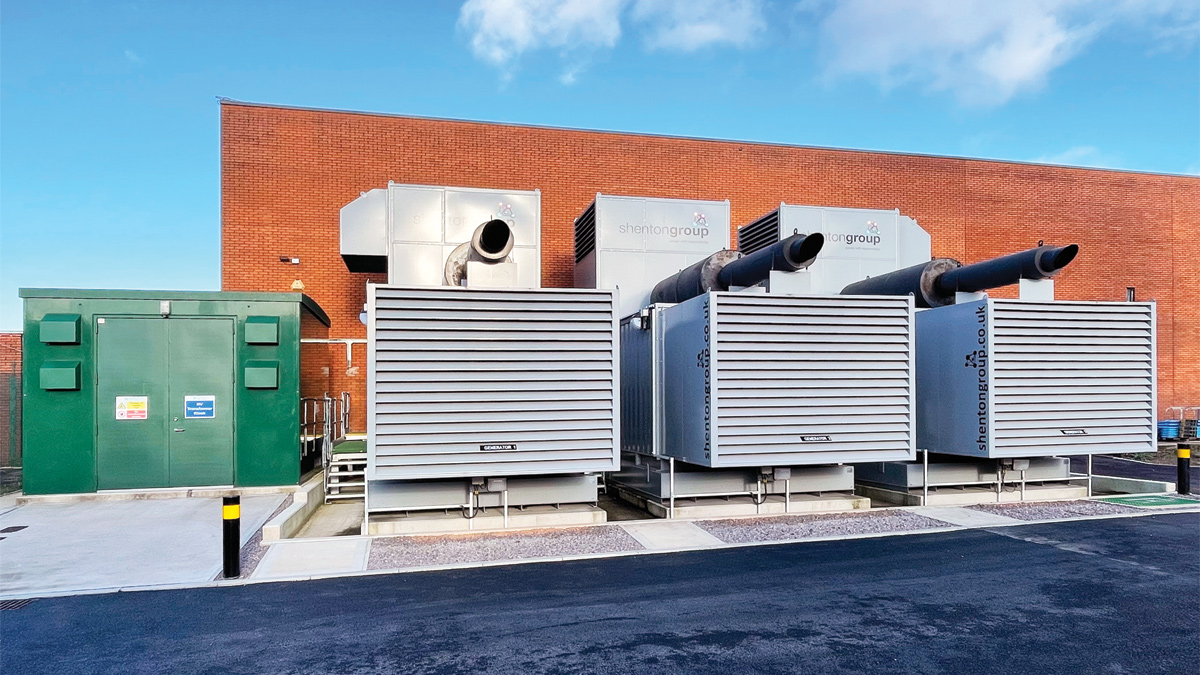
3 (No.) 1.27MVA generators and transformer kiosk - Courtesy of Arup
Cardiff Western District Sewage Pumping Station (CWD SPS) receives sewage from the western area of Cardiff for onward pumping to Cog Moors WwTW via twin rising mains. The pumping station is a strategic asset and is operationally critical to Welsh Water. Failure of this asset would have severe business impacts. During AMP6, a root cause analysis study was carried out to establish risk areas for the site. This identified a number of root causes giving rise to operational risks. It was decided that high priority items relating to the power supply and control hardware would be dealt with by this project.
Background and project driver
The pumping station was constructed in 1978 to replace the original 1905 station; which has now been converted to an antiques shop. The pumping station currently comprises of a screening chamber, foul pumping station, storm pumping station, storm storage tank and storm/emergency outfall into the River Ely. Over time, the functionality and operation of the site has changed with the introduction of storm storage and modification to the consent. This, in combination with many aged assets, has meant that considerable time and effort is being spent by the operational team to ensure the site remains functional.
From the AMP6 investigation the following high priority issues were to be resolved by this project:
- The capacity of the mains power supply to the site is insufficient, particularly in storm conditions. Therefore supplementary power is provided by four 636kVA Mirrlees Blackstone generators, which are 44 years old. These generators have aging components which are now obsolete and asset life expired. Because these components are no longer supported with readily available spares, long outages are expected should major components fail.
- Failure of the control system could lead to Cardiff Western District Pumping Station not being able to pump the required pass forward flow to Cog Moors WwTW. This will lead to consent failure. This could be caused by the age of the control system, with much of the equipment being obsolete and having historical add-ons with limited records of the changes made. In addition, the SCADA is hosted on an obsolete operating system that is not supported by the manufacturer with regular security updates. This poses a cyber-security risk.
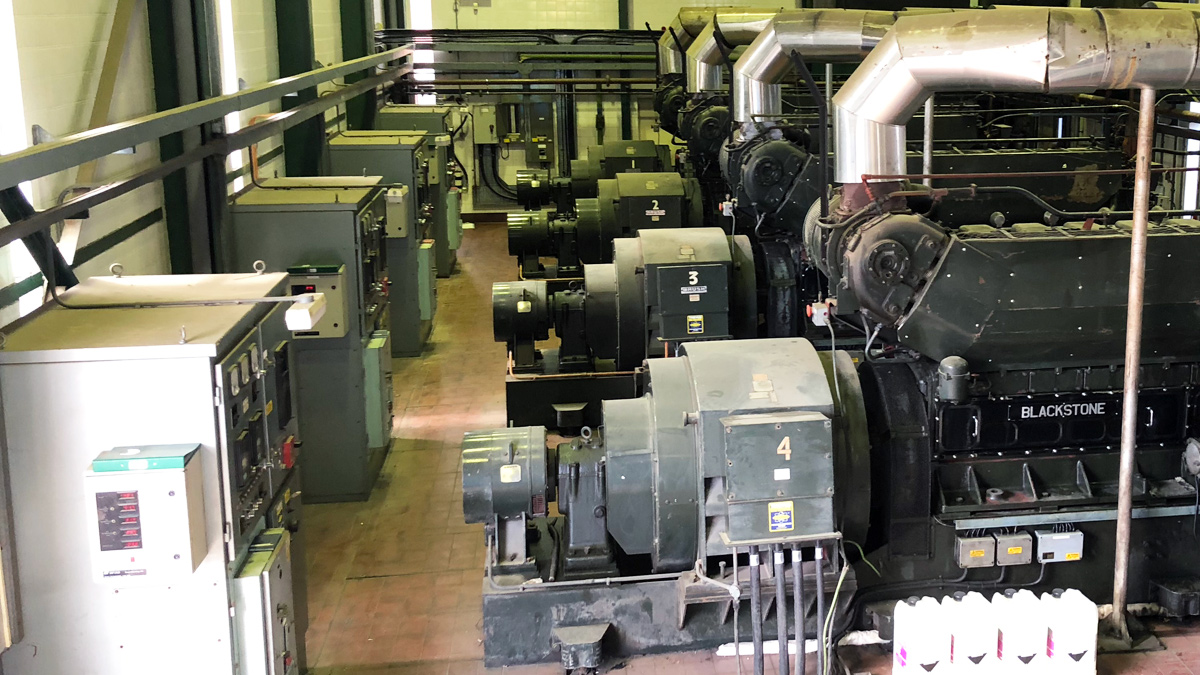
The 44 year old 636kVA Mirrlees Blackstone generators in the Cardiff Western District SPS pump hall – Courtesy of Arup
Design and project implementation
At the outset, the project team engaged in proactive engagement/negotiation with the distribution network operator, Western Power Distribution (WPD). These conversations highlighted the extra capacity in the wider local network which helped unlock the blockers on the site supply constraint.
Following acceptance from WPD, the scope was developed to replace the existing HV and LV infrastructure with a 2.5MVA transformer, a vacuum circuit breaker (for isolation by Welsh Water), a circuit breaker (for isolation by WPD), 3 (No.) 1.27MVA generators and a low voltage distribution board (LVDB) for LV power distribution across the site. Future-proofing and expansion of the site was incorporated into the design through the addition of an LV feeder for a future MCC at the LVDB.
Engagement with the Welsh Water stakeholders led to the location of the generators and transformer in front of the pumping station building because the design team realised early on that locating the new generator sets within the pumping station building would lead to potential noise and ventilation issues and structural modifications being required to accommodate large LV cables. Early engagement with the project stakeholders and the site operations personnel also ensured that the pump station operations was understood in detail to inform phasing and understand risks so these could be planned and mitigated (e.g. electrical network phasing). The power supply upgrade application was submitted and accepted by WPD on the condition that the Welsh Water HV substation was connected to WPD’s new 11kV ring power supply by September 2018.
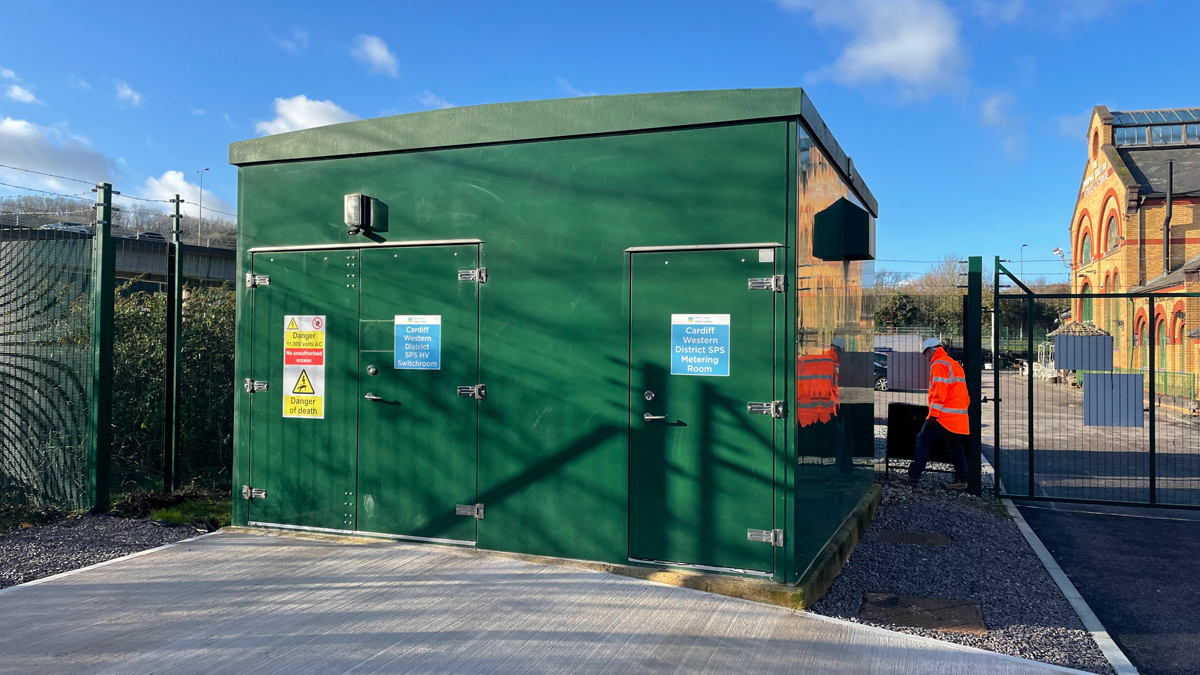
HV switchroom and metering room – Courtesy of Arup
The infrastructure design was laid out in a systematic manner to facilitate construction whilst minimising impacts on site operational activities. A 3D model of the site was created using a point cloud survey. This model formed the basis of the construction drawings and was useful in visualising the construction sequence and designing the complex cabling routes in and out of the pumping station building.
Design for Manufacture and Assembly (DfMA) approach was used for the design of the LVDB and generators. Access to the LVDB and generators is provided via structural steel platforms. These platforms have been installed with lightweight GRP walkway solutions instead of heavy metal open mesh flooring to mitigate any damage to the single core LV cables due to accidental dropping of the flooring.
Instead of the conventional bulk tank arrangement for diesel storage, it was decided to use under belly tanks at Cardiff Western District. This decision meant that more space was available on an already constrained site for other site activities. Additionally, it mitigates any potential security issues that could arise due to the visible presence of a bulk diesel storage tank on site.
Early contractor involvement, which allowed for utilisation of the supply chain’s expertise, was a key factor in the quick design progression. This included the undertaking of a wire-by-wire survey to validate as-built information. The survey identified equipment and interfaces to ensure that the correct operation of the existing works was maintained at all times, during the installation and commissioning phases. The engagement with the supply chain led to the provision of lifting beams in each generator enclosure to minimise heavy lifting of the generator air circuit breakers (ACBs) by Welsh Water operations staff.
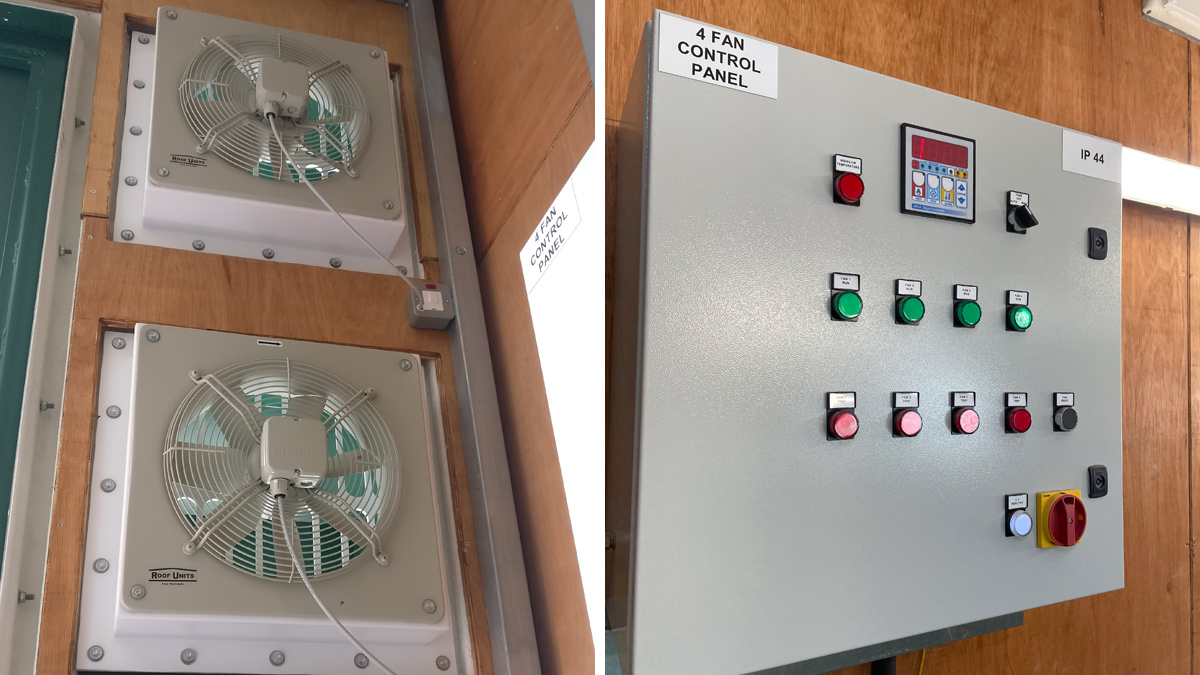
(left) Forced ventilation provided for the transformer and (right) fan control panel provided in the transformer kiosk for ventilation – Courtesy of Arup
At the technical design review stage, it became apparent that the natural ventilation provided by the transformer kiosk was not adequate to keep the transformer within the prescribed temperature limits. The design team worked closely with Morgan Marine, the kiosk supplier, to provide forced ventilation fans and integrated the fans within the transformer kiosk along with definition of controls requirements.
Site control system
Before the upgrade, the SCADA system on site was the Intellution MX32 hosted on a desktop system running on Windows XP and the main PLC was a Mitsubishi A-series PLC. Both the PLC and SCADA are now obsolete and were replaced with a new PLC system housed within a new ICA section and a new Servelec Technologies Enterprise SCADA desk client. Interconnection has been provided between the new ICA section and the LVDB. The ICA/SCADA design has allowed for connectivity to a future MCC and any (additional) future expansion.
The complexity of the integration of the new equipment into the existing site meant that the new generators operated in two modes; as temporary supplementary generators and permanent standby generators.
To facilitate the operation in temporary mode, the main site control panel (MCC1) was modified by installing new mains and generator incomer sections. Therefore, the PLC and SCADA systems were designed to ensure the operability and monitoring of the generators in both modes.
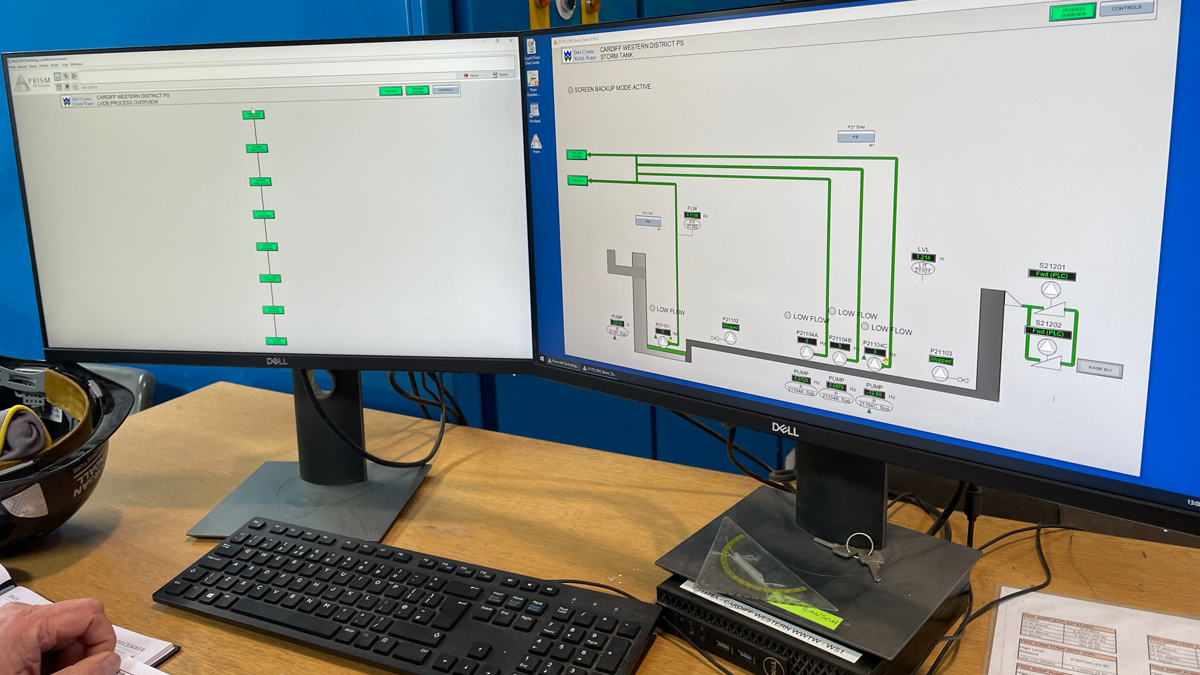
The new site SCADA client system from Servelec Technologies – Courtesy of Arup
Cardiff WDPS: Supply chain – key participants
- Client: Welsh Water
- Principal contractor: Morgan Sindall Construction & Infrastructure Ltd
- Designer: Arup
- Geotechnical investigation: Geotechnics Ltd
- Mechanical installation: Whitland Engineering Ltd
- HV electrical installation & earthing contractor: Hornbill Engineering Ltd
- HV switchgear contractor: SPE Energy Ltd
- LV switchgear contractor: General Panel Systems Ltd
- LV electrical installation: Zone Electrical Ltd
- Generators: Shenton Group UK
- Kiosks: Morgan Marine
- Software integration: General Panel Systems Ltd via GPS Links
- SCADA: Servelec Technologies
Construction phase
The construction phase was carefully planned to ensure the pumping station operated effectively and within its consented operating parameters and to minimise the number of power outages required to deliver the works. Business continuity plans (BCPs) were developed for all power outages to manage the associated risks and contingency planning. The majority of the construction works were undertaken during nationwide restrictions due to Covid-19.
The initial phase of work was to secure the new 11kV mains power supply which saw the construction of the WPD HV switch kiosk and the Welsh Water HV switch and metering kiosk with a temporary connection onto the existing site 11kV mains cable and transformer. This installation was key to securing the increased supply and enable the remaining scope to be delivered.
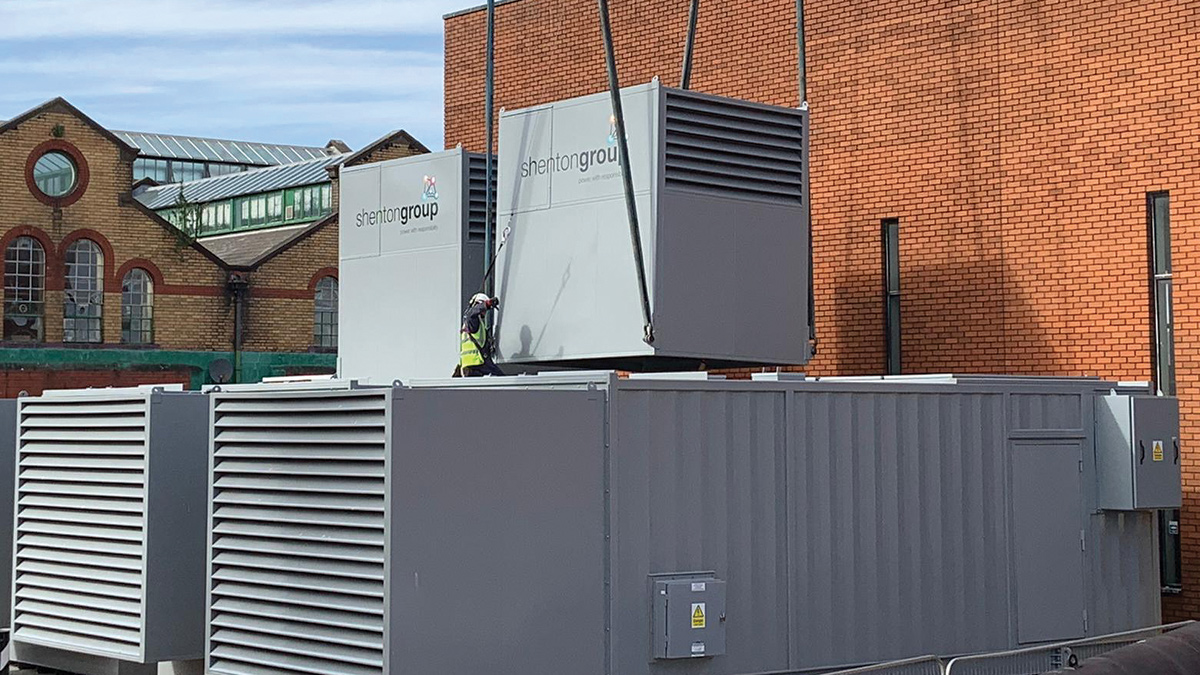
Installation of the new generators – Courtesy of Arup
Main construction works commenced with the installation of a temporary bulk diesel tank for the original supplementary generators to enable the original bulk tanks to be decommissioned and removed from site as they stood within the footprint planned for the new generators. The new generators base was constructed with a reinforced in situ concrete slab founded on 24 (No.) 400mm diameter, 16m long, sectional flight auger (SFA) piles which were in close proximity to the two critical rising mains that leave the site.
The three new Shenton generators were delivered to site on multiple lorries where they were craned into position and built up on site. Modifications to the existing MCC kiosk and panels and the installation of temporary cables enabled the new generators to be brought into service in supplementary power mode to allow the original Mirrlees Blackstone generators to be removed from service.
Removal of the Mirrlees Blackstone generators was undertaken as part of the contract with Shenton Group. This commenced with the removal of all electrical connections and the draining of all fluids.
All ancillary equipment such as fuel lines, bulk fuel day tanks, air compressors, exhausts etc. were removed leaving just the main body of the generators intact. Removal of the generators used an innovative method of using tracks and rollers to manoeuvre the generators out of the generator hall safely and swiftly.
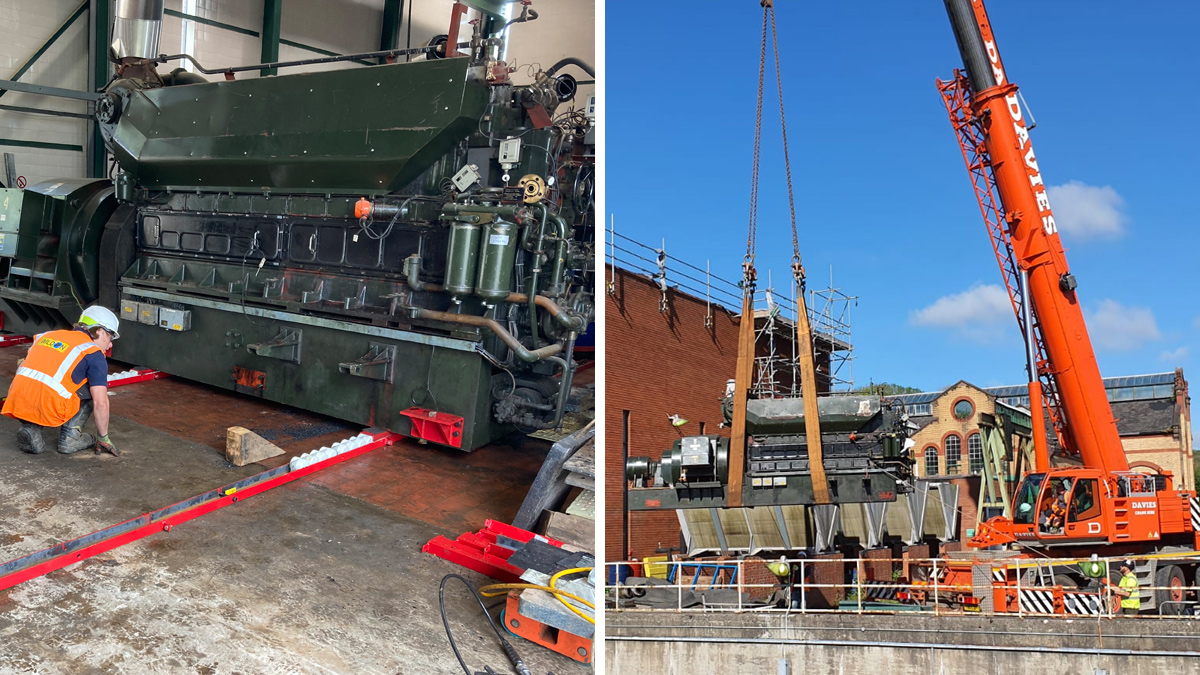
Removal of original generators – Courtesy of Morgan Sindall
This method of removing the old generators without stripping down on site vastly reduced the amount of work on site and reduced the number of lifts required for the removal process.
The installation of the new LVDB platform and LVDB was carried out after the generator hall was emptied. All components were fabricated off site to the maximum size possible to minimise the installation time and requirements on site. Electrical installation then followed for the new LV power, signal and control networks to connect the new generators, existing MCC panels and new LVDB together. Following successful testing and commissioning of the new LVDB, a major milestone was achieved in the changeover of the new Shenton generators from supplementary power to standby power mode and the commissioning of the new 2.5MVA HV transformer.
Remote factory acceptance test trial
The factory acceptance testing of the new generators coincided with the first Covid-19 lockdown. This prevented in-person witnessing of the Factory Acceptance Test (FAT). Delaying or cancelling the test would have a negative knock-on effect on the project programme and cost. The project team successfully carried out a remote FAT using Microsoft Teams. Shenton made use of laptops and mobile phones to enable attendees view the generators in detail and monitor the operation of the generators.
This remote FAT approach was adapted for other equipment to a hybrid mode when lockdown restrictions relaxed to allow for a limited number of people to be physically present at the test site. A good example was during the FAT for the low voltage distribution board where two members of the project team observed the FAT in person at the General Panel Systems Ltd factory in Bristol while the rest of the team watched via Microsoft Teams. A thorough Site Acceptance Test (SAT) was carried out as each piece of equipment was delivered to site.
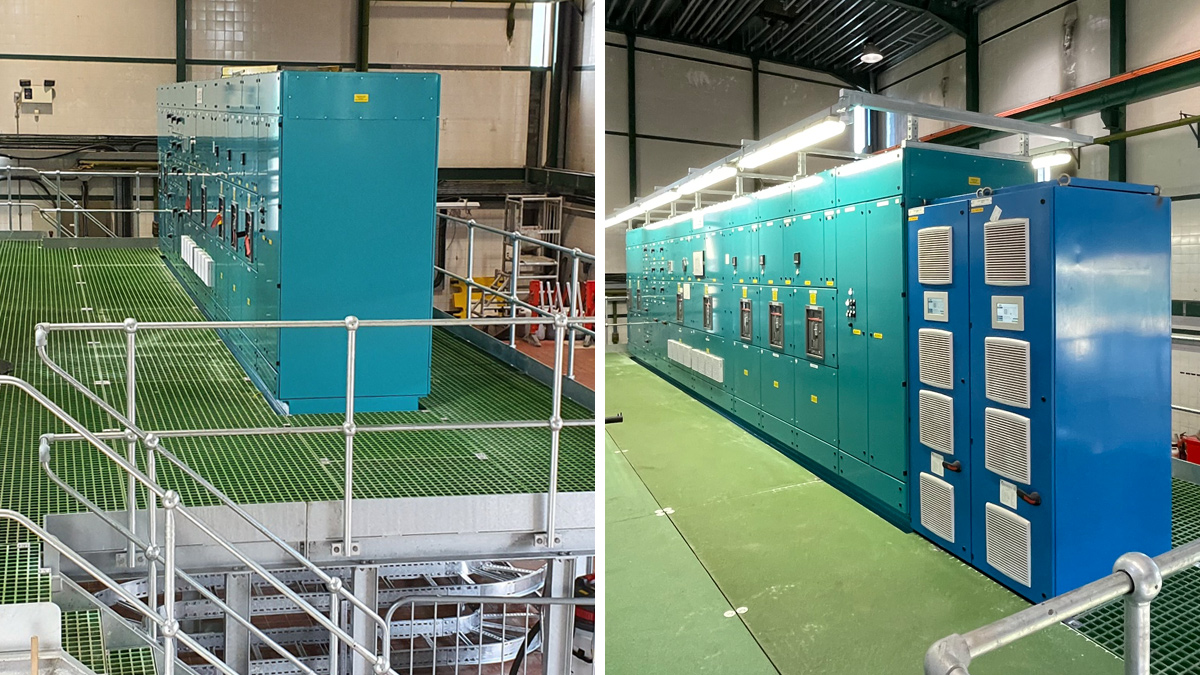
(left) The low voltage distribution board in the cleared generator hall and (right) the low voltage distribution board and relocated active harmonic filters mounted on a structural steel platform – Courtesy of Arup
Sustainability/environmental consideration
The inclusion of the remote FATs meant that there was a reduction in travel therefore lowering health and safety risks and the project team’s carbon footprint.
The roof of the main building at Cardiff Western District SPS was re-covered during the construction phase. The new roof covering is made from an eco-friendly waterproofing material called Dericolor Olivine. It reduces the ecological footprint of the building and improves the quality of air in the area.
Although obsolete, the Mirrlees Blackstone generators have been properly maintained over the years and are still in good working condition. The generators and ancillary equipment have been donated to the Anson Engine Museum, Cheshire.
Conclusion and project status
As of January 2022, the site construction was complete and handover was in progress. The site has now been livened to the new power supply and the generators are operating in a standby mode. The increased resilience of the power infrastructure ensures that the other risk areas identified in the root cause analysis report can be addressed.






